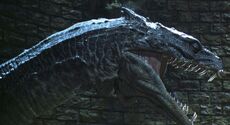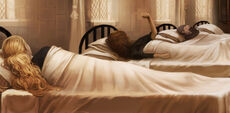Hunnie Bunn (talk | contribs) (Undo revision 745708 by 75.53.80.150 (talk) Whilst that is true, not in the Harry Potter universe.) |
Tag: sourceedit |
||
| (21 intermediate revisions by 10 users not shown) | |||
| Line 1: | Line 1: | ||
| + | {{Wonderbookold}} |
||
| − | [[File: |
+ | [[File:Slytherin's_basilisk.jpg|thumb|230px|A basilisk, whose indirect gaze causes petrification.]] |
| ⚫ | |||
| + | [[File:Petrified.jpg|thumb|230px|Victims of Petrification turned to stone]] |
||
| ⚫ | |||
| ⚫ | |||
| ⚫ | '''Petrification''' is the process of being turned to stone. The only proven causes of petrification are the gaze of the [[Gorgon]] and the [[Basilisk]], the latter only when reflected in or seen through another object. However, there may be a [[Dark Arts|Dark spell]] that does the same. It is considered to be dark magic of the most advanced kind, of which no normal [[second year]] student could accomplish. |
||
| ⚫ | |||
| + | |||
| ⚫ | |||
==Effects== |
==Effects== |
||
| Line 11: | Line 14: | ||
The [[Full Body-Bind Curse]] is similar to petrification, but it is temporary, easily lifted, and the victim is fully conscious, thus it is not nearly as dangerous. [[Transmogrifian Torture]] has been said by [[Gilderoy Lockhart]] to cause death and petrification; however, the truth of his claims are dubious. |
The [[Full Body-Bind Curse]] is similar to petrification, but it is temporary, easily lifted, and the victim is fully conscious, thus it is not nearly as dangerous. [[Transmogrifian Torture]] has been said by [[Gilderoy Lockhart]] to cause death and petrification; however, the truth of his claims are dubious. |
||
| − | In [[1940s|1943]] and [[1992]], [[Salazar Slytherin]]'s [[Salazar Slytherin's Basilisk|Basilisk]] was released from the [[Chamber of Secrets]] in [[Hogwarts School of Witchcraft and Wizardry|Hogwarts]] and petrified several [[Muggle-born]] students; in the former case, one student, [[Myrtle]], was killed.<ref>''[[Harry Potter and the Chamber of Secrets]]''</ref> |
+ | In [[1940s|1943]] and [[1992]], [[Salazar Slytherin]]'s [[Salazar Slytherin's Basilisk|Basilisk]] was released from the [[Chamber of Secrets]] in [[Hogwarts School of Witchcraft and Wizardry|Hogwarts]] and petrified several [[Muggle-born]] students; in the former case, one student, [[Myrtle Warren]], was killed.<ref>''[[Harry Potter and the Chamber of Secrets]]''</ref> |
| − | ==Known victims |
+ | ==Known victims== |
| + | {| class="wikitable" border="1" 500px;" |
||
| − | [[File:Justin_petrified_COS_1.jpg|thumb|250px|Justin Finch-Fletchley shortly after his petrification]] |
||
| + | |- |
||
| ⚫ | |||
| + | ! align="center" width="20%" |Victim |
||
| ⚫ | |||
| + | ! scope="col" |Instance |
||
| ⚫ | |||
| + | |- |
||
| ⚫ | |||
| + | |[[Mrs. Norris]] |
||
| ⚫ | |||
| ⚫ | |||
| ⚫ | |||
| + | |- |
||
| + | |[[Colin Creevey]] |
||
| ⚫ | |||
| + | |- |
||
| + | |[[Nicholas de Mimsy-Porpington]] |
||
| ⚫ | |||
| + | |- |
||
| + | |[[Justin Finch-Fletchley]] |
||
| ⚫ | |||
| + | [[File:Justin petrified COS 1.jpg|thumb|left|230px]] |
||
| + | |- |
||
| + | |[[Hermione Granger]] |
||
| ⚫ | |||
| + | |- |
||
| + | |[[Penelope Clearwater]] |
||
| ⚫ | |||
| + | |} |
||
| + | *Students of Hogwarts (1943) - during the incident of the first unleashing of the beast in 1943, three Hogwarts students were petrified. |
||
==Etymology== |
==Etymology== |
||
| − | + | The Latin verb ''petrificare'' means "to make into stone", from the Latin word for "rock", ''petra''. |
|
==Behind the scenes== |
==Behind the scenes== |
||
| − | [[File: |
+ | [[File:Nearly headless nick petrified basilisk.jpg|thumb|200px|Nearly Headless Nick petrified.]] |
| − | * |
+ | *It is unknown how [[Nicholas de Mimsy-Porpington|Nearly Headless Nick]] was revived from being petrified, because, as a [[ghost]], he presumably would not have been able to consume the antidote. (However, as petrified humans cannot consume potions either, being unconscious, perhaps the antidote is administered in a way that could also revive ghosts.) |
| − | * |
+ | *In mythology, petrification is associated with [[Wikipedia:Medusa|Medusa]] the [[Gorgon]] and the [[cockatrice]] as well as the basilisk. In Cornish folklore, petrification legends explain the origin of prehistoric megalithic monuments, such as the Merry Maidens stone circle.<ref>[[Wikipedia:Petrification|Petrification]]</ref> |
| − | * |
+ | *In the ''[[Harry Potter and the Philosopher's Stone (film)|film adaptation]]'' of ''[[Harry Potter and the Philosopher's Stone]]'', [[Quirinus Quirrell]] appeared to be turned to stone when touched by Harry, due to the latter's [[Sacrificial Protection|counter-charm]] reacting to Voldemort (to whom Quirrell was biological linked), and eventually crumbled apart. This form of petrification was not seen in anywhere else in the series. |
==Appearances== |
==Appearances== |
||
| Line 37: | Line 58: | ||
*''[[Harry Potter: A Pop-Up Book]]'' {{Mention}} |
*''[[Harry Potter: A Pop-Up Book]]'' {{Mention}} |
||
*''[[Harry Potter Trading Card Game]]'' |
*''[[Harry Potter Trading Card Game]]'' |
||
| + | *''[[Pottermore]]'' |
||
| + | *''[[Wonderbook: Book of Spells]]'' |
||
| + | *[[Harry Potter: The Creature Vault]] (mentioned only) |
||
==Notes and references== |
==Notes and references== |
||
{{Reflist}} |
{{Reflist}} |
||
| + | |||
| + | [[es:Petrificación]] |
||
[[Category:Articles related to basilisks]] |
[[Category:Articles related to basilisks]] |
||
[[Category:Dark Magic]] |
[[Category:Dark Magic]] |
||
Revision as of 12:34, 27 March 2016

A basilisk, whose indirect gaze causes petrification.

Victims of Petrification turned to stone
- "Dark Magic of the most advanced kind."
- — Albus Dumbledore on petrification[src]
Petrification is the process of being turned to stone. The only proven causes of petrification are the gaze of the Gorgon and the Basilisk, the latter only when reflected in or seen through another object. However, there may be a Dark spell that does the same. It is considered to be dark magic of the most advanced kind, of which no normal second year student could accomplish.
It should not be confused with the Full Body-Bind Curse or the Hardening Charm.
Effects
Victims of petrification are paralysed and unmovable, and seem to be unconscious; it takes careful examination to discern whether a victim is petrified or dead. The difference between petrification and death is that the petrified victim appears to enter rigor mortis instantaneously and remains that way, while a dead person enters, and leaves it, within a normal timeframe. A petrified ghost will turn a dark smoky grey and can only be moved using a fan. The only effective remedy for petrification is a draught made of Mandrake roots.
The Full Body-Bind Curse is similar to petrification, but it is temporary, easily lifted, and the victim is fully conscious, thus it is not nearly as dangerous. Transmogrifian Torture has been said by Gilderoy Lockhart to cause death and petrification; however, the truth of his claims are dubious.
In 1943 and 1992, Salazar Slytherin's Basilisk was released from the Chamber of Secrets in Hogwarts and petrified several Muggle-born students; in the former case, one student, Myrtle Warren, was killed.[1]
Known victims
| Victim | Instance |
|---|---|
| Mrs. Norris | Saw the basilisk's reflection in the water on the floor. |
| Colin Creevey | Saw the basilisk through his camera; the basilisk's gaze also burned his camera's film to a crisp. |
| Nicholas de Mimsy-Porpington | Saw the basilisk directly, but, as a ghost, he could not die again. |
| Justin Finch-Fletchley | Saw the basilisk through Nick, who was transparent.
 |
| Hermione Granger | Saw the basilisk in Penelope's mirror. |
| Penelope Clearwater | Saw the basilisk in her mirror; it is possible that Penelope is half-blooded and was only subject to an attack because she was there when the basilisk petrified Hermione, a Muggle-born, but it is unknown. |
- Students of Hogwarts (1943) - during the incident of the first unleashing of the beast in 1943, three Hogwarts students were petrified.
Etymology
The Latin verb petrificare means "to make into stone", from the Latin word for "rock", petra.
Behind the scenes

Nearly Headless Nick petrified.
- It is unknown how Nearly Headless Nick was revived from being petrified, because, as a ghost, he presumably would not have been able to consume the antidote. (However, as petrified humans cannot consume potions either, being unconscious, perhaps the antidote is administered in a way that could also revive ghosts.)
- In mythology, petrification is associated with Medusa the Gorgon and the cockatrice as well as the basilisk. In Cornish folklore, petrification legends explain the origin of prehistoric megalithic monuments, such as the Merry Maidens stone circle.[2]
- In the film adaptation of Harry Potter and the Philosopher's Stone, Quirinus Quirrell appeared to be turned to stone when touched by Harry, due to the latter's counter-charm reacting to Voldemort (to whom Quirrell was biological linked), and eventually crumbled apart. This form of petrification was not seen in anywhere else in the series.
Appearances
- Harry Potter and the Chamber of Secrets (First appearance)
- Harry Potter and the Chamber of Secrets (film)
- Harry Potter and the Chamber of Secrets (video game)
- Harry Potter: A Pop-Up Book (Mentioned only)
- Harry Potter Trading Card Game
- Pottermore
- Wonderbook: Book of Spells
- Harry Potter: The Creature Vault (mentioned only)
